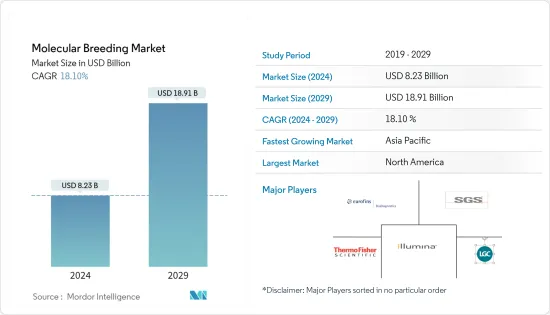
분자 육종 시장 규모는 2024년 82억 3,000만 달러로 추정되며, 2029년까지 189억 1,000만 달러에 이를 것으로 예측되며, 예측 기간(2024-2029년) 동안 18.10%의 연평균 복합 성장률(CAGR)로 성장할 전망입니다.

새로운 작물 품종을 개발하는 과정은 거의 20-25년이 걸리지만, 생명공학을 사용하면 이 기간을 거의 7-8년으로 단축할 수 있습니다. 마커 지원 선발(MAS)과 같은 도구를 사용하면 과학자들은 보다 생산적인 결과를 얻을 수 있는 식물 형질을 보다 쉽고 빠르게 선택할 수 있습니다. 분자 육종 기술은 초기 단계에 있습니다. 네덜란드와 영국에서는 새로운 품종의 작물에 분자 육종 기술이 100% 채용되고 있습니다. 종자 회사의 주요 기업은 종자 품종의 개선을 위해 이러한 기술을 채택합니다. 유전자 부문과 조사 부문의 가격 하락은 시장 개선으로 이어집니다. 공공 부문뿐만 아니라 민간 부문으로부터도 자금이, 밭이나 야채 작물에 있어서의 게놈 선발이나 MAS의 응용 등의 식물 육종이나 유전자 조사를 향해 흐르고 있어, 장래에는 시장이 활성화될 것입니다. 분자 성장 시장은 예측 기간 동안 아시아태평양에서 가장 성장할 것으로 예측됩니다.
식량 생산과 소비에 대한 세계 수요는 급속히 증가하고 있습니다. 미국의 평균 옥수수 수율은 20세기 초반의 1.6톤/헥타르에서 약 9.5톤/헥타르까지 증가했습니다. 극적인 수율 향상은 하이브리드 옥수수, 합성 비료의 사용 및 분자 육종 시장을 추진하는 새로운 농법의 채택 때문입니다. 분자 육종 형질의 도입과 DNA 기반 마커를 이용한 새로운 육종 기술의 개발은 분자 육종의 새로운 혁신적인 시장을 창출했습니다. 예를 들어 향후 20년 동안 생명공학 특성과 마커 지원 육종으로 미국 옥수수 수율이 두 배가 될 수 있습니다.
2017년 분자 육종 시장에서는 북미가 최대 점유율을 차지하고 분자 육종의 이점에 대해 농가들 사이에서 인식이 높아지고 있어 밀과 옥수수의 생산고가 높아졌기 때문에 유럽이 이어졌지만, 이에 따라 미래에는 시장이 넓어질 것으로 보입니다. 시장. 미국과 캐나다에 이어 유럽에서 대기업의 존재로 인해 분자 육종 시장의 채용이 증가하고 있습니다. 아시아태평양의 분자 성장 시장은 인도, 중국, 태국 등 주요 기업의 투자 증가로 인해 가장 높은 비율로 성장할 것으로 예상됩니다.
분자 육종 시장은 고도로 세분화되고 있으며, 대기업은 시장에 발자국을 남기기 위해 제품 가격 분석, 신제품 개발, 인수와 합병, 확대, 파트너십 등 많은 전략을 채택해 왔습니다. 신젠타와 같은 대기업은 ``Thermofisher Scientific''의 고도로 수정된 제노타이핑 플랫폼을 사용하여 육종 파이프라인에 필요한 데이터를 제공하고 보다 우수한 수율 가능성을 가진 새로운 품종을 신속하게 선택합니다.
The Molecular Breeding Market size is estimated at USD 8.23 billion in 2024, and is expected to reach USD 18.91 billion by 2029, growing at a CAGR of 18.10% during the forecast period (2024-2029).

The process of developing new crop varieties almost takes around 20- 25 years but this time limit can be shortened to almost 7-8 years by using biotechnology. Tools like marker-assisted selection (MAS) make it easier and faster for the scientist to select plant traits with more productive results. Molecular breeding technology is in the nascent stage. Netherland and UK witnessed 100% adoption of molecular breeding techniques for new crop variety. Major players in seed companies have been adopting these technologies for improvement in seed varieties. The decline of prices in the genetic and research departments leads to the improvement of the market. Funds flow from private as well as public sectors towards plant breeding and genetic research such as genomic selection in field and vegetable crops and application of MAS will gear up the market in the future. The molecular breeding market is projected to grow highest in the Asia-Pacific region during the forecast period.
Global demand for food production and consumption increasing at a rapid pace. U.S. average corn yield has increased from 1.6tonnes/hectare in the first half of the 20th century to approximately 9.5tonnes/ha. The dramatic yield improvement is due to the use of hybrid corn, synthetic fertilizers, and the adoption of new farm practices that drives the molecular breeding market. Introduction of molecular breeding traits and development of new breeding technology using DNA based markers created a new and innovative market for molecular breeding. For instance, Over the next two decades, biotechnology traits and marker-assisted breeding have the potential to double the corn yields in the U.S.
North America accounted for the largest share in the molecular breeding market in 2017, followed by Europe due to high yield in the production of wheat and maize as awareness among the farmers about the benefits of molecular breeding are increasing which will create a scope in the future market. The presence of major companies in US and Canada followed by Europe has resulted in increasing adoption of the molecular breeding market. The Molecular breeding market in the Asia-Pacific region is projected to grow with highest rate due to increasing investment from the key players in countries such as India, China, and Thailand.
The molecular breeding market is highly fragmented and major players have used many strategies such as pricing analysis of the product, new product development, acquisition and mergers, expansion, the partnership to make a footprint in the market. Major players like Syngenta using advance modified genotyping platforms from "Thermo Fisher Scientific" to provide necessary data for the breeding pipeline to quickly select the new varieties with much better yield potential.